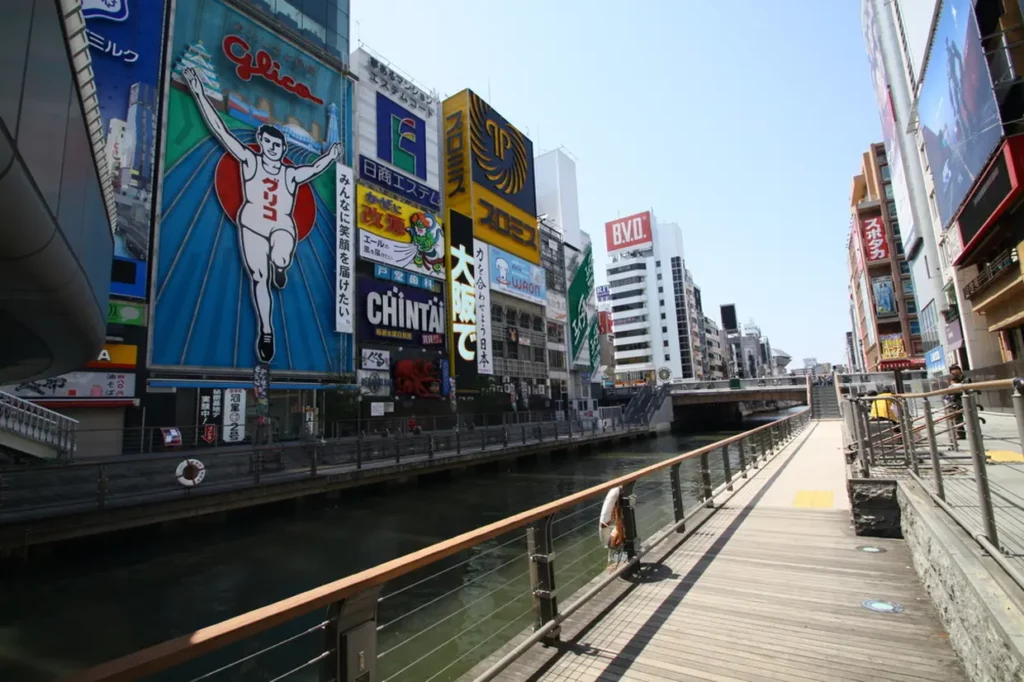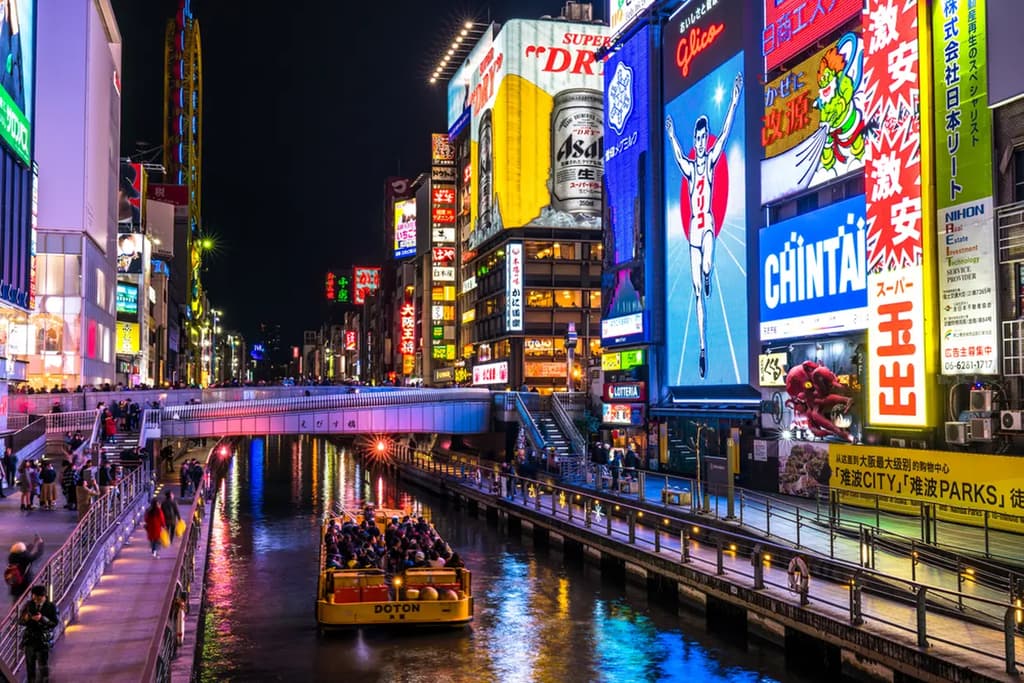Dotonbori is one of Osaka’s most popular tourist destinations, with its lively shopping district and restaurants. The area is home to the famous Glico sign and other colorful neon lights that add color to the night. This article introduces some of the classic sightseeing spots in the Dotonbori area, as well as places where you can have a unique Japanese experience!
To learn more about Osaka, click here!
The Shopping District of Dodonbori (道頓堀商店会)

The Dotonbori shopping district is one of Osaka’s most popular tourist attractions. Along the Dotonbori River, restaurants and stores with flashy signboards unique to Osaka line the river. Glico signboards and Kuidaore Taro dolls that come to mind when thinking of Osaka can also be found here.
Many stores selling takoyaki (octopus dumplings), okonomiyaki (okonomiyaki), and kushikatsu (skewered pork cutlets), which are Osaka’s most famous gourmet foods, line the streets here, allowing visitors to fully enjoy Osaka’s culinary delights. Located close to Namba, the center of Osaka, it has become a symbolic place for Osaka citizens.
Dotonbori Glico sign (道頓堀グリコサイン)

One of the most popular photo spots in Osaka is this Dotonbori Glico sign. This picture was first installed in 1935. Since then, it has been renewed many times with the changing times, and the current design has been loved by visitors.
The classic spot to take a picture with the Glico sign is on the Ebisu Bridge. When you go to this location, you will see many people posing for photos in the same pose. The sidewalk one step down from Ebisu Bridge is also a good photo spot. It is less crowded and you can get even closer to the Glico sign to take pictures. From the Tonbori Walk on the other side of the river, the Glico sign can be seen in front of the bridge, giving a different atmosphere to the photo.
Kuidaore Taro(くいだおれ太郎)

Osaka is said to be a city of “Kuidaore” means to spend too much money on food and drink and become poor. Kuidaore Taro was the signature character of Osaka Meibutsu Kuidaore, a long-established restaurant that closed once in 2008. After the restaurant closed, he was revived as an Osaka specialty and now beats the drum at the entrance of the building.
The building sells many Osaka souvenirs, especially Kuidaore Taro goods. Stop by not only to take pictures, but also to purchase souvenirs.
Tombori River Walk (とんぼりリバーウォーク)

Tombori River Walk is a promenade along the Dotonbori River. Visitors can take a leisurely stroll along the riverside and fully enjoy the Osaka cityscape. You can pass under 9 bridges over the Dotonbori River and enjoy the beautiful neon lights reflected on the water at night. There are also riverside restaurants accessible from the promenade, where you can take a break while enjoying the view of the river.
Cruises are also recommended, including the Tombori River Cruise, a 20-minute mini cruise of Dotonbori, the Tombori River Jazz Boat, which allows sightseeing in Dotonbori with live jazz music, and the Naniwa Exploration Cruise with a rakugo storyteller, which is guided by a rakugo performer.
Other fun events are also held on an irregular basis, so check the website.
Doutonbori giant feriss wheel “Ebisu Tower” (道頓堀大観覧車えびすタワー)

The Ebisu Tower is the world’s first elliptical Ferris wheel, attached to the Don Quijote Dotonbori store. 4-seater gondolas rotate horizontally in about 15 minutes.
It is popular among tourists as the closest place to the sky along Dotonbori, and when you reach the highest point at 77.4 meters, you can see the downtown area and Abeno Harukas. The view from the all-glass structure is exhilarating and thrilling.
Osaka Shochikuza Theatre (大阪松竹座)

Osaka Shochikuza Theatre was established in Dotonbori in 1923 as Japan’s first stylized theater, and in 1997 it was renovated as a theater specializing in theatrical performances, retaining its symbolic Neo-Renaissance-style front arch and introducing the latest equipment. The theater presents all kinds of performing arts, mainly Kabuki performances, as well as musicals.
The entrance on the first floor is finished in a European style with sand beige Italian marble on the walls and floor, with the Neo-Renaissance arches on the exterior walls, while on the second floor, the floor is carpeted in a Japanese style and 12 Japanese paintings on the left and right walls are themed on the four seasons in Japan. The theater hall is on the third floor, and the chairs, walls, and floor are based on the color red, creating a theater space that is free from everyday life. The design of the building is also noteworthy.
Hozenji Temple (法善寺)

Hozenji Temple is a power spot that can be reached on foot from Dotonbori. The temple is famous for its moss-covered Mizukake Fudo (Water Hanging Fudo). It is said that your wish will come true if you pour water from a well over the statue when you visit the temple. Hozenji Yokocho is located nearby and is also recommended for sightseeing.
Hozenji Yokocho Alley (法善寺横丁)

This retro side street appears when you take a little side street from the Dotonbori shopping street. The stone pavement is impressive, and Hozenji Temple is located just past the alley. The atmosphere is even better at night.
Two alleys, 80 meters long and 3 meters wide, stretch east to west in Yokocho, lined with long-established kappo restaurants, bars, okonomiyaki and kushikatsu (skewered pork cutlet) stores. Enjoy the unique atmosphere that can only be found here.
Kamigata Ukiyoe Museum (上方浮世絵館)
Kamigata Ukiyoe Museum is the only museum in the world that permanently exhibits Kamigata Ukiyoe. Kamigata Ukiyoe refers to actor pictures depicting kabuki plays in Dotonbori, which were produced mainly in Osaka from the late Edo period to the early Meiji period.
The museum is a cozy four-story building with each floor measuring approximately 60 square meters, displaying about 30 works from the museum’s collection. The first floor is a general store, and visitors are welcome to drop by.
Ninja Experience Cafe Osaka Dotonbori (忍者体験カフェ大阪道頓堀)
Just a two-minute walk from the symbolic Glico sign in Osaka, there is a cafe where you can experience being a ninja. You will be amazed at the various fun tricks, such as the revolving door, also known as the “Dontenkai,” and the hole that leads from the ceiling to the room, not to mention the training in shuriken and blowgun.
There is also a “walk-around” option that allows visitors to go out dressed in ninja gear. Taking a picture with the Glico sign while dressed as a ninja will be a unique experience.
Tea Ceremony Osaka The Osaka (茶道体験The Osaka)

Dotonbori also offers a tea ceremony experience facility. The tea ceremony is a deeply traditional Japanese experience in which powdered green tea is prepared and served to guests in a traditional tea room. It is not only about drinking matcha, but also about the meaning behind every object and every gesture, and the 500-year history of the tea ceremony can be felt. Here, you can learn the tea ceremony directly from a tea ceremony instructor and make and drink your own matcha tea. To accompany the matcha, seasonal wagashi (Japanese sweets) are also offered, which vary according to the time of year.
Reservations can be made in advance or on the day of the event, depending on availability. Reservations can be made through the official website or by phone or SNS. Enjoy the unique art performed in a quiet environment.
To learn more about Osaka, click here!


